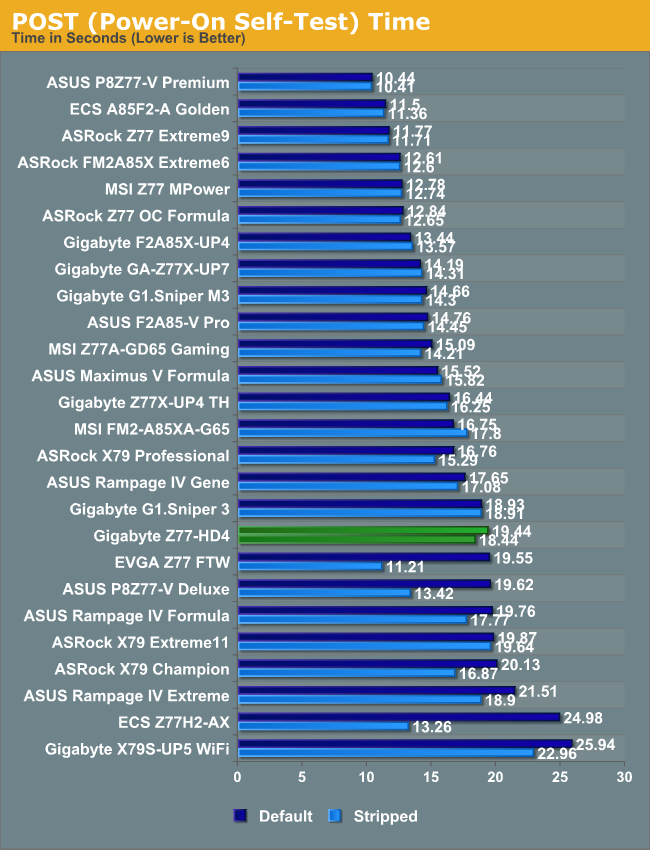Gigabyte Z77-HD4 Review
by Ian Cutress on May 19, 2013 10:00 AM EST- Posted in
- Motherboards
- Gigabyte
- Z77
Many thanks to...
We must thank the following companies for kindly providing hardware for our test bed:
Thank you to OCZ for providing us with 1250W Gold Power Supplies.
Thank you to G.Skill for providing us with the memory kits.
Thank you to ASUS for providing us with the AMD GPUs and some IO Testing kit.
Thank you to ECS for providing us with the NVIDIA GPUs.
Thank you to Corsair for providing us with the Corsair H80i CLC.
Thank you to Rosewill for providing us with the 500W Platinum Power Supply for mITX testing, BlackHawk Ultra, and 1600W Hercules PSU for extreme dual CPU + quad GPU testing, and RK-9100 keyboards.
Test Setup
Power Consumption
Power consumption was tested on the system as a whole with a wall meter connected to the OCZ 1250W power supply, while in a dual 7970 GPU configuration. This power supply is Gold rated, and as I am in the UK on a 230-240 V supply, leads to ~75% efficiency > 50W, and 90%+ efficiency at 250W, which is suitable for both idle and multi-GPU loading. This method of power reading allows us to compare the power management of the UEFI and the board to supply components with power under load, and includes typical PSU losses due to efficiency. These are the real world values that consumers may expect from a typical system (minus the monitor) using this motherboard.
While this method for power measurement may not be ideal, and you feel these numbers are not representative due to the high wattage power supply being used (we use the same PSU to remain consistent over a series of reviews, and the fact that some boards on our test bed get tested with three or four high powered GPUs), the important point to take away is the relationship between the numbers. These boards are all under the same conditions, and thus the differences between them should be easy to spot.

For a low cost motherboard with few features, we would expect it to have a lower power consumption than that of a mid-range Z77 motherboard. The truth of the matter is that as a board is more expensive, especially at the high end, component efficiency is a factor in the overall board cost. As a result, the Z77-HD4 does well at idle and CPU load, but breaks over 500 W in Metro2033.
POST Time
Different motherboards have different POST sequences before an operating system is initialized. A lot of this is dependent on the board itself, and POST boot time is determined by the controllers on board (and the sequence of how those extras are organized). As part of our testing, we are now going to look at the POST Boot Time - this is the time from pressing the ON button on the computer to when Windows starts loading. (We discount Windows loading as it is highly variable given Windows specific features.) These results are subject to human error, so please allow +/- 1 second in these results.

With fewer controllers, a cheaper motherboard would be expected to POST quicker than a more indepth motherboard. But it would seem that the cheaper motherboards also have less time spent optimising the POST sequence. As a result, the default boot time with two GPUs is north of 18 seconds. The fact that the second GPU had to be in an x4 slot via the PCH may also be a factor in this.










63 Comments
View All Comments
Razorbak86 - Tuesday, May 21, 2013 - link
Why is it out of place? Because it references China?Do you realize how large the Chinese Internet cafe market is? Manufacturers often design products to meet specific market needs, and then end up selling those same products to other market segments.
I really don't understand the level of consternation over that one innocuous comment in a 7-page review. I honestly think that some commenters' negative reactions to that statement are more telling about their own insecurities or prejudices than they are a statement of the author's perspective. JMHO.
popej - Wednesday, May 22, 2013 - link
Your audio test are of very limited value. 16bit test is not enough to show performance of better chips and loop-back test shows limitation of audio input, when usually audio output quality is what is interesting.You have presented 6 test for USB transfer. Imagine that you have posted only USB 2.0 copy test. This would be an equivalent of what have you done to audio testing.
RoslynWan12 - Wednesday, May 22, 2013 - link
If you think Dawn`s story is exceptional..., in the last-month my daughter basically got $6525 just sitting there an eleven hour week from there apartment and their buddy's sister`s neighbour was doing this for four months and brought home over $6525 part time on there mac. applie the instructions available on this page Bow6.comTAKE A LOOK